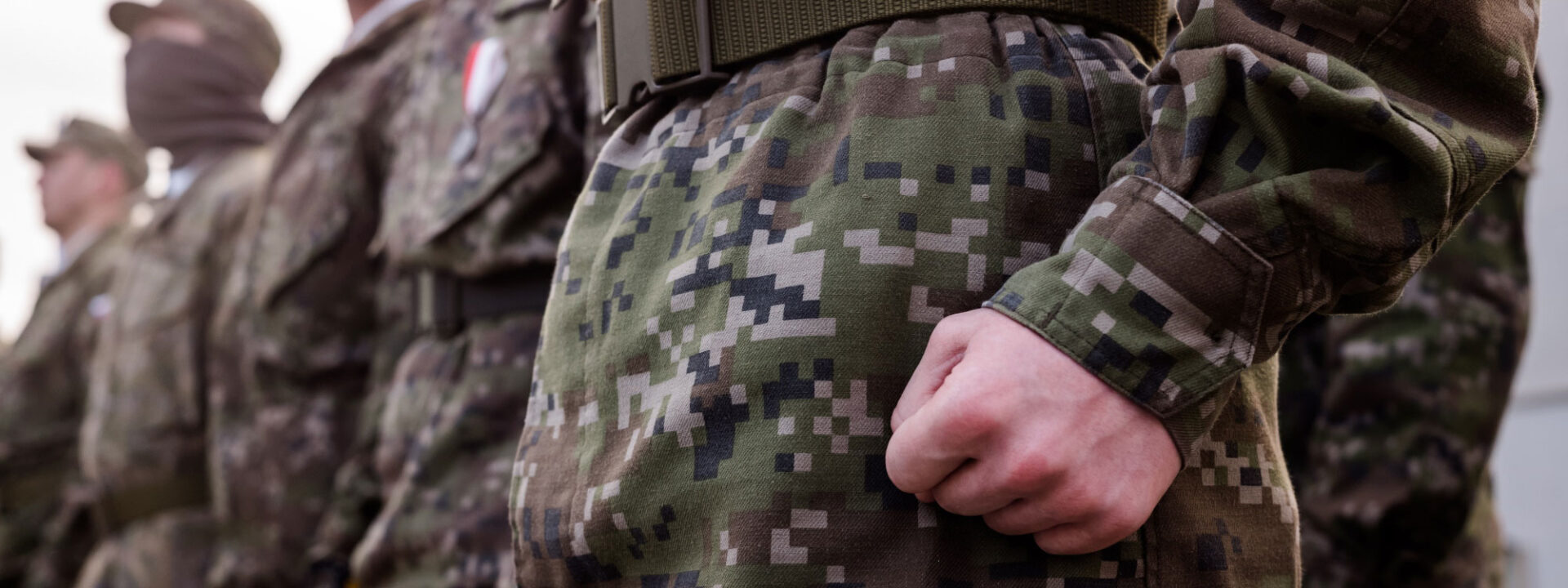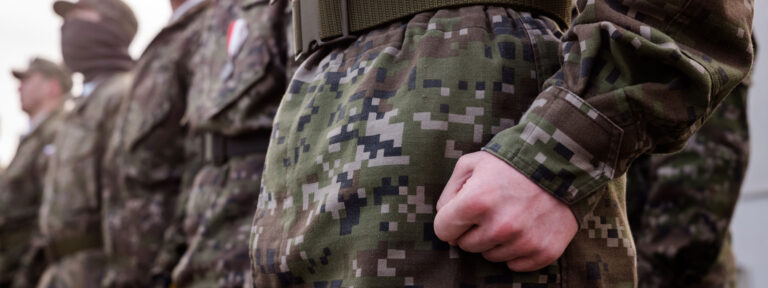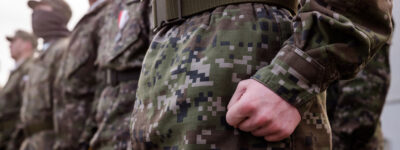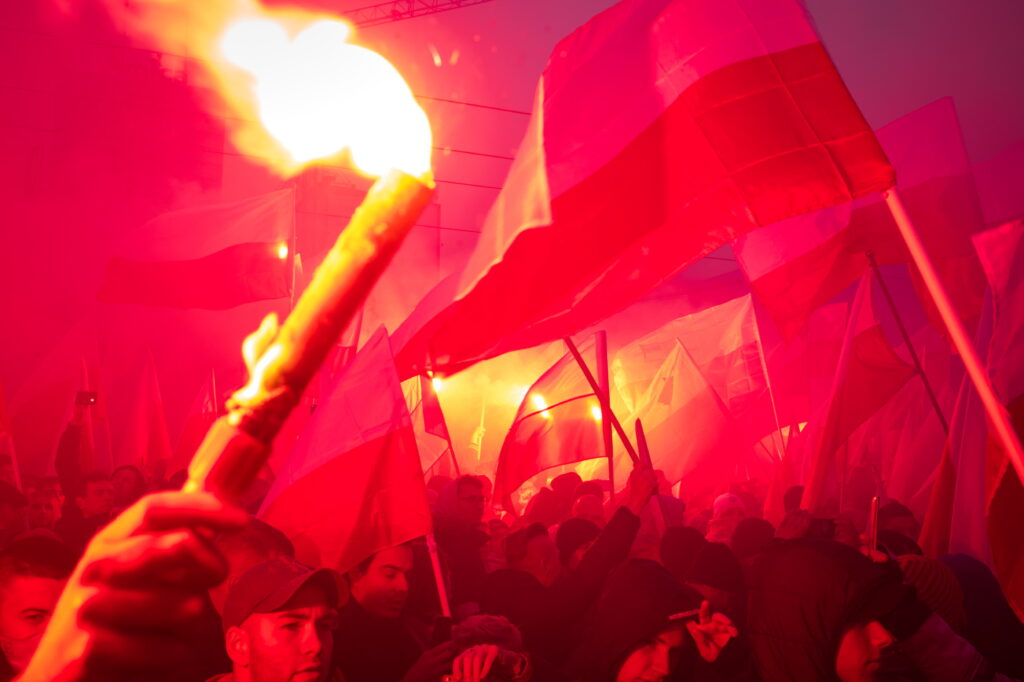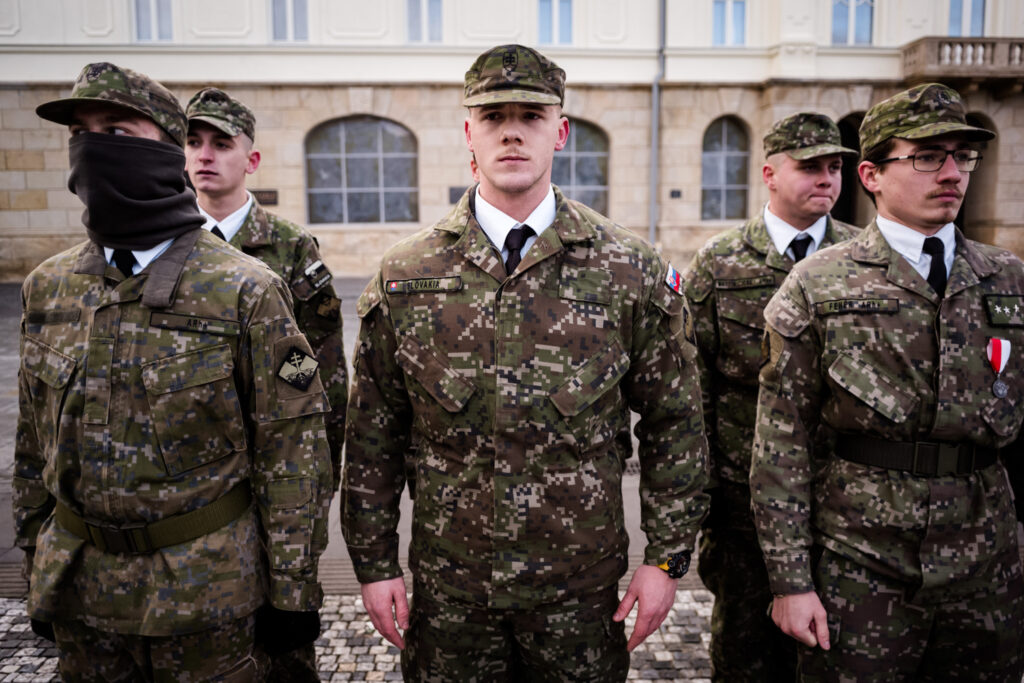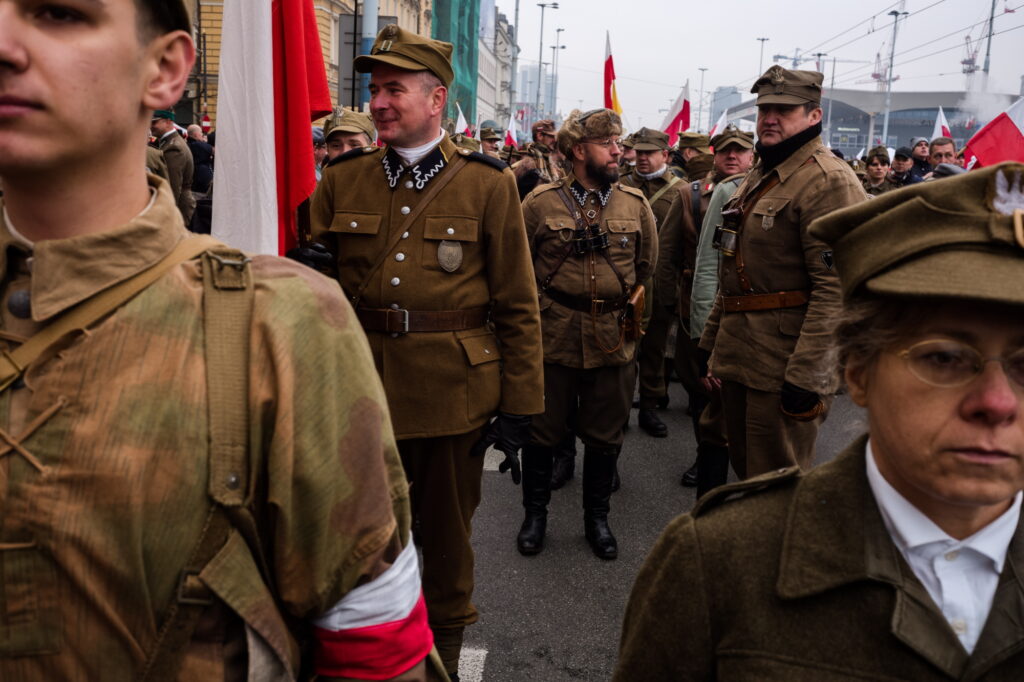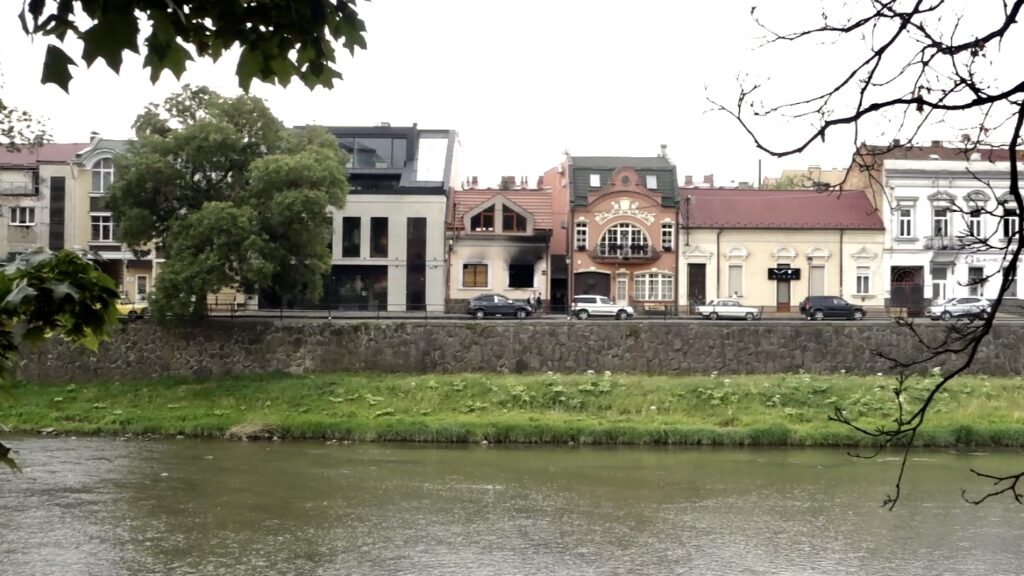School celebrations, patriotic marches and national holidays. All accompanied by ever-present weapons and green uniforms. In countries of the Central Europe patriotism increasingly means militarism, and civil values are being displaced by the cult of weapons and combat. Nobody controls this movement. VSquare special report shows, that states are supporting amateur militarists on an unprecedented scale.
Two or three years of compulsory military service for everyone. School exercises where teens have to shoot, crawl wearing gas masks and dress fake shrapnel wounds. In cinemas, war shown as an adventure. This is what the governments of Warsaw Pact states did to strengthen patriotic attitudes of their citizens before 1989.
When the Berlin Wall fell, as Central Europe transitioned to a liberal democracy and acceded to NATO, it started on a gradual process of demilitarization. Not disarmament – after the accession to NATO the national armies increased their potential and combat readiness – but social demilitarization. For more than twenty years, civil state was the model. A patriotic citizen was expected to pay taxes, love the country and work for the benefit of the state.
But as PhD researcher Weronika Grzebalska, who specializes in militarism, points in her article, in recent years, this model of statehood and citizenship has been seriously compromised. “The (Central and Eastern European – VSquare) region has experienced a significant rise in the number and visibility of grassroots paramilitary actors ranging from anti-refugee vigilantes in Bulgaria and Hungary through pro-Kremlin militias in Slovakia and Czech Republic to a civilian component cooperating with the armed forces in the Baltics and Poland.”
Today, patriotism in several countries of Central Europe is coupled with militarism. It is a new kind of patriotism – overgrown, which regards the welfare of one’s own people and community as a value superior to the rest of the world. In this model, the ambition of one’s own country and nation can be pursued at the expense of others. From here, it is just one step away from nationalism.
All-catholic Poland
What is patriotism in Central Europe today? This is perhaps most vividly illustrated by the example of Poland.
November 11, 2018 in Warsaw. The March of Independence, a massive procession on the anniversary of Poland’s independence in 1918. The biggest national-patriotic manifestation in Europe: 100,000 people are expected to arrive to the Polish capital.
The march is organized by a nationalist March of Independence Association (Stowarzyszenie Marsz Niepodległości) – its activists come from the National Movement (Ruch Narodowy), a xenophobic group that has been sitting in the Polish Parliament since 2015. Order is kept by the March of Independence Guard – an informal movement of volunteers. The Guard is not registered anywhere, it is a group of several hundred nationalists who train under the guidance of former special forces and the French Foreign Legion soldiers. Despite being a typical security service, in their exercises they learn military techniques. They do not wear uniforms, they adhere to military discipline.
In the centre of Warsaw, next to the communist-built, impressive Palace of Culture and Science, crowds have been gathering since the morning. The nationalists can be heard chanting ‘With sickle, with hammer let’s treat the red rabble’ and ‘For a change, instead of leaves commies hanging from the trees’. Red and white flags are fluttering, along with banners reading ‘Poland must be Catholic, not secular’ and ‘Wake up, Poland, return to God’. Many are wearing elements of Polish uniforms.
Activists of the National Movement are fundraising with metal boxes. The place is full of stalls selling patriotic gadgets. Groups of hooligan fans are posing for photos with burning flares.
After 2 pm, the march starts off. At its head, accompanied by the police and the army, march politicians of Law and Justice (PiS), Poland’s ruling party: the informal head of state Jarosław Kaczynski with a white-and-red flag, prime minister Mateusz Morawiecki, deputy speakers of the Parliament and president Andrzej Duda. But the officials set off separately, before the rest of the march – this gives the impression they are not part of the nationalist gathering. The rest of the participants wait quietly. They shout ‘God, honor, fatherland’ and to reporters working for private media ‘Go to Berlin’, ‘Communists and thieves, Poland is laughing at you’, and ‘Raise your hearts, fuck TVN’. In official government propaganda, media owned by foreign entities (including the private, American-owned TV station TVN and German RASP-owned printed press) are the enemies of the ‘healthy tissue of the nation’.
Children in military uniforms stand out from the crowd. Their parents are marching with them, some also in uniforms, including some from World War II. They are not members of any organization. This is how they manifest their patriotism. Just like those wearing badges with the letter P inscribed in the letter W. This is the so-called ‘anchor’, the graphic symbol of the Polish Underground State. It used to denote Fighting (W) Poland (P). The ‘anchor’ was invented during World War II as a symbol of resistance – however, over the past several years it has been appropriated by the far-right and used together with xenophobic slogans. The symbol is eagerly used by groups of hooligans and nationalists.
What is it that the ‘anchor’ patriots are opposing today? The European Union, secularity, liberal values. The list goes on.
Here comes another chant: ‘No rainbow, no secularity – Poland must be Catholic’. The march sets off amid yelling, with ‘Honor and glory to the heroes’ mixing with ‘For a change, instead of leaves commies hanging from the trees’. You can hear the rumble of firecrackers. The white-and-red flags dominate, but there are also flags of the Italian Forza Nuova, an organization with fascist sympathies.
Ziemowit Przebitkowski, the leader of the nationalist All-Polish Youth (Młodzież Wszechpolska) calls to action: ’Our biggest national vice is passivity, there is no other way to make our nation great. We need to start acting, organizing ourselves’.
Robert Winnicki, a Member of Parliament for the nationalist National Movement: ’We need to fight against the liberals and Marxists who want to take over our Church’
In the evening, the police say that 250,000 people took part in the march.
A Slovak recruit gets a number
Early January 2019, the town of Trnava, Slovakia. Young people in uniforms are gathering by Trojičné Námestie, a 19th century old town market. Half a hundred of them are waiting for their commander’s instructions in a parking lot. They are soon to march into the market to celebrate the seventh anniversary of the paramilitary formation Slovenskí Branci (Slovak Recruits).
At first, the men are wary of reporters. When we start talking, the distrust disappears. One of them speaks English, but calls it an ‘imperialist pseudo-language’.
‘Left, left, left!’ screams the leader loudly as the men form a column. The march is entering the square. In the crowd of onlookers you can see Ján Čarnogurský, the former prime minister of Slovakia and his son, a prominent lawyer and businessman.
It is time for speeches. When Peter Švrček, the head of Slovenskí Branci addresses the audience, his voice changes from joyful to very loud and forceful. ‘We act legally and without financial support from the oligarchy’ boasts Švrček.
This is not entirely true: even though Slovenskí Branci organize military-like exercises where they teach volunteers to shoot guns, they are not a registered organization. Permits for their gatherings are filed for by Švrček as a natural person.
The leader of the group is self-confident. He is polite beyond compare, articulate and persuasive. He takes criticism calmly, with a smile on his face. He has radical views and charisma. If it were up to him, he would put up a wall on the border – he wants to protect his homeland from the invasion of refugees, to provide citizens with security, and cure the ‘sick’ society. The welfare of his own people and his own community is the superior value. To achieve that, Slovenskí Branci were founded.
Švrcek has a mission: take care of a generation which, according to him, has been neglected, left without guidance or authority figures. When he established the organization in 2012, he was a teenager and was supported by a few buddies. Today, more than 200 young men are in its ranks. They meet at weekends to do military training. Švrcek is aware of how important discipline is. He relies on fear, and requires obedience. He assigns numbers to recruits, instead of names.
Slovenskí Branci offer their help in the organization of official ceremonies, and they use the opportunity to encourage people to join their ranks. They also promote nationalist ideas among school children. All this in a narrative which has changed over the years, from far-right to pro-Russian.
When he was only 15 years old, the leader of Slovenskí Branci underwent training with a Russian militia Narodny Sobor. During the three-week-long stay in Russia, he was trained by former Spetsnaz soldiers. Since then, he has been passing on his experience to other members of the group.
Švrček is the protagonist of a documentary ‘When the War Comes’ by Czech journalist and filmmaker Jan Gebert.
The second speaker at the event in Trnava is Ján Čarnogurský, a former dissident, former prime minister and a long-time leader of the Slovak Christian Democratic Party. Despite his beautiful past record, today he is mainly known for his pro-Russian sympathies, protests against NATO and an initiative to build a monument for Soviet army leader marshal Konev (responsible for the suppression of an anti-communist uprising in Hungary in 1956). Čarnogurský’s activities are regularly reported by a conspiracy website hlavnespravy.sk. ‘Slovenskí Branci have to be treated with respect and experts should be helping them with their ideals to defend Slovakia’ – declares the former prime minister. In an interview with VSquare he adds that if he was still in power, he would certainly be helping the organization. Currently Branci have no connections with governmental structures.
The ceremony ends in the afternoon, in a hotel restaurant. Over hot chicken soup, the leaders thank the Čarnogurský family for their support and have another round of short speeches. Most of them given by commander Švrček. He talks about ‘non-standard’ solutions to government ‘attacks’ on the organization (probably about the audit of Slovenskí Branci ordered by the MInistry of Defence). He does not specify exactly what kind of solutions he means. ‘The truth always wins and I believe that we stand on the side of victory. Because we stand on the side of truth’ he says.
Hungary: strong with tradition and sports
In Hungary, the militarization of patriotism is quieter.
Csobánc, a hill in western Hungary near lake Balaton is known for its wine: the volcanic soil gives it an extraordinary taste. The hill is a popular spot with wealthy urban people – many own holiday homes or vineyards here.
One of the paths leads to the top of the 376-meter-high hill and goes around the ruins of the Castle of Csobánc. Built in the Middle Ages, it played a key role in the battles between the Ottoman and Hungarian forces in the 16th century. It was abandoned and blown up at the beginning of the 18th century and is in ruins.
But for a group of people who call themselves the László Gyulaffy Historical Re-enactment Horse-Mounted Banderium (Gyulaffy László Hagyományőrző Lovasbandérium), the castle is a symbol of former power. It is not by accident that they called themselves a ‘banderium’ – a name given to a special military formation in the Middle Ages. The group was founded in 2003 and named after one of the brave captains of the Castle of Csobánc.
The group has ten ’horse-mounted soldiers’, fifteen ’foot soldiers’ and ’artillerymen.’ They are working on the reconstruction of the castle and are also taking part in historical re-enactment shows in replicas of 16th century costumes and weapons. They use swords, daggers and shields.
The Hungarian ministry of defense has been supporting the Csobánc Banderium. In the past five years, the group received more than 7,500 euros from the ministry’s fund for NGOs. According to data that Vsquare and its Hungarian partner Atlatszo received from the ministry, the Csobánc re-enactment group was given 4,400 euros total in 2014 and 2015 for ’military re-enactment equipment’ and another 3,115 euros in 2017 for ’military-educational programs’.
It is just one of the many re-enactment groups which are financially supported by the Victor Orban government. Over the past five years, the Hungarian ministry of defense spent 692,000 euros on re-enactment enthusiasts.
As Vsquare has found out, the amounts spent by the Hungarian ministry of defense on NGOs have significantly risen in the past five years. In 2014, the total amount of subsidies was 760,000 euros, which rose to close to 5.6 million euros by last year.
The Orban Government spent as much as 92% of the budget of the ministry of development dedicated for NGOs for those involved in sports. The Military Sports Association got 3.46 million euros from that amount. The mission of the Association is to ‘strengthen the Hungarian citizen’s patriotic commitment to defend their homeland, to strengthen their readiness for sacrifice, and to include a wider and wider group of citizens in the development and upkeep of the defense capabilities of Hungary in a voluntary manner’. In addition to this – to teach skills to children that are useful in the ‘defense of the homeland’ such as map reading and survival skills.
The government also works directly to make pupils more patriotic. Former minister of defense István Simicskó was recently appointed as Government Commissioner for Patriotic Education. On news channel HírTV Simicskó said that he wants to include patriotic education in different, currently existing subjects such as geography and history. Simicskó gives the impression of being progressive: he reiterates that his aim is not to turn pupils into soldiers. Instead, he wants to create a ‘healthy national identity’ in school kids, one that would ‘benefit the defense of the homeland.’
In 2016, Orban announced that he wants shooting ranges to be built around the country. Soon after that his then minister János Lázár announced that the government would spend approx. 81 million euros in building 197 shooting ranges. The aim of the program: to teach young people to shoot ‘in a safe environment.’
The Polish government follows suit. A government program called ‘Shooting range in every municipality’ has been in place since 2017. The shooting ranges are to be funded by the ministry of defense. The ministry’s project shows that the facilities would be built for… civilian purposes. Each municipality will be able to obtain grants to build its own shooting range. In 10 years, the Polish state will spend close to 116 million euros for this program. The Law and Justice party says the program to build shooting ranges is needed because Poland has no compulsory military service.
Army recruiting at Czech schools
The Czech ministry of the interior publishes a quarterly report on the activities of extremist groups. According to the reports in 2018, the number of paramilitary groups is going down. Main reasons? The Ministry names ‘personal hostility, power disputes and discord as to the direction of the organization’. In short: rows.
The ministry monitors the two major groups: Czechoslovak Armed Reserve for Peace (Československí vojáci v záloze za mír) and the National Militia (Národní domobrana). Their activity is no different from other similar groups in Visegrad countries. According to the ministry report, both have direct links to separatists in Ukraine and connections with members of political parties. The remaining groups are ephemeral, almost virtual, and the activity of their members comes down to welcoming Russian bikers from the Night Wolves group during their annual, ostentatious trip from Moscow to Berlin.
The landscape of Czech paramilitary groups is not as rich as in the other countries of Central Europe.
At the beginning of 2018, the National Militia (Národní domobrana) split due to internal disputes. A few members formed a new group – Zemská domobrana. The group has only a few members and is ideologically close to Slovenskí Branci (both groups maintain contacts with each other).
‘Zemská domobrana is trying to limit its public appearances and strengthen other activities’ says the report from 2018. The biggest change is educational activity among young people and children. Zemská domobrana promotes defense education. ‘Some groups are founded on xenophobia and racism and negate the foreign policy of the Czech Republic. In this case, the teaching of national defense by such groups can be considered a significant threat to security’ warns the ministry in a report from August 2018.
A Czech political expert Peter Kupka believes that the absence of large and important paramilitary groups in the Czech Republic has several reasons: ‘First, the police have enough capabilities to expose them quickly. Second, establishing such an organization is very risky today. In the past, the founders ended up in jail for similar attempts. Thirdly, the tradition of paramilitary organizations is at a different level in the Czech Republic than in Poland.’
Czech Republic is the most secular state in the region. Does this mean that it has adopted the Western model of a civil state? It did not have to – it had never abandoned it in the first place.
The army is not a popular career path. Until recently, the it tried to attract young people with high pay, but the method has not been working. Meanwhile, the Czech ministry of defense has an ambitious target: 30,000 soldiers in the regular army by 2026.
This is how the military came to schools. In 2012, the Czech parliament passed a law on defense education in schools. The ministry set up a special organization called Preparation of Citizens to Defend the Country (POKOS, Příprava občanů k obraně státu). The government-organized POKOS is the only organization caring for defense education.
In the peaceful society, the formation of POKOS sparked controversy. The idea was criticized by organizations monitoring access to weapons. Meanwhile, children in schools are attracted by military presentations, which have been criticized by Hanka Zoor Svačinková from an NGO Nesehnutí: ‘I have seen a lesson given by POKOS, carried out by soldiers. They put guns in children’s hands. To me, this looks like a recruitment technique’.
When the law was being passed, František Šulc was the chief advisor to the Czech defense minister. He has no problem with the presentations by POKOS: ‘Weapons are part of our society. I think it’s better to show weapons to children under supervision. If you deny the existence of weapons, they will not disappear’.
Šulc acknowledges that the army is using presentations in schools as an early recruitment method: ‘If the children have enough information, they can easily become soldiers. The situation on the labor market will be more difficult, and the army needs to do what other industries are doing’.
VSquare talked to a soldier of the Czech army who has taken part in several POKOS presentations. From his point of view, everything was in accordance with the rules: ‘Every soldier knows that it is forbidden to aim a gun at people. If any child does it, it means the soldier showing them the equipment failed. We (the soldiers – VSquare) all know that this is unethical. Of course, we show the weapons, but nothing can happen. We don’t even have ammunition with us. (…) I think that kids may not be harmed by knowing, for example, how to give first aid. What’s more, they will also know that the army is there and it is actually doing something’. When we ask about the paramilitary groups, the soldier is surprised: ‘I’ve never heard of such groups. I just know there are guys who like to play airsoft in the woods’.
František Šulc, former advisor to the ministry of defense: ‘If you look at the history, we have never had such traditions here. Militarism has never become a mainstream that could change the way the society thinks’.
In the Czech Republic, unlike neighboring Slovakia, anti-immigrant or racist slogans are the domain of mainstream politicians, not military groups. President Miloš Zeman is known for such statements, and so is the Czech-Japanese far-right politician Tomio Okamura, the leader of the Freedom and Democracy party (his support is at between 4% and 10% in the best polls). Although Okamura is trying to ‘sell’ xenophobia as his main program, he is not reaching a wider audience.
‘I believe that organized political violence would not been supported in the Czech Republic. When we look at the aesthetics of paramilitarism, which includes a certain degree of exclusivity, the overuse of the symbols of unity and marching in uniforms, I do not think that such an organization has any significant support in the Czech Republic, as there is in Slovakia,’ explains Petr Kupka.
Cursed soldier, a model for the young
In Poland, after the election of 2015 won by the right-wing party Law and Justice (PiS), things changed. PiS was the first party after 1989, since the fall of communism, to focus on values such as honor and nation. Today, this means praising martyrs (heroes of the Warsaw Uprising of 1944 and, most importantly, the so-called ‘cursed soldiers’ who fought against communism after the war) and contempt for ‘slanderers’ – everyone who stands in the way of ‘true patriots’. This kind of patriotism feeds on the glorifying, collective sacrifice from the time of World War II.
To understand why some participants of the March of Independence parade in historical uniforms from World War II, you need a pinch of history. In 1945, the Polish Underground State ceased to exist, the Home Army was disbanded, and its members were called on to work for independence by other means than armed resistance. But not everyone gave up guerrilla warfare – abandoned and left to their own devices, hunted down and cornered, they felt betrayed and confused, unable to find a place. For many of them, to fight and shoot was the only option left. There were approximately 22-25 thousand of them in 1945-47. They carried over the ethos of the fight against occupation to the new reality, but they understood it differently. Some supported the fight to save democracy, others would go into the woods to fight against security forces, defeat Belarusians, Ukrainians and Jews. They are called ‘cursed soldiers’.
Prof. Antoni Dudek, historian: “Anyone who is willing to do it, can read about the dark sides of the cursed soldiers on the internet. But this cult promoted by the government has reached such proportions today, that gradually it gets ridiculed. With time, this exaggeration will inevitably spur opposition”.
There were both righteous and depraved people among the cursed soldiers. Thanks to PiS, they now have their national holiday. But the official celebrations for ‘cursed soldiers’ are not about debate, or truth, or memory. They are about a cult used to support the new myth and the new legitimacy of Poland ruled by PiS.
Since 2015, the Cursed Soldiers Day has been a political and ideological cult, a rite of initiation into the Catholic-national martyrdom. A tool used to segregate Poles into patriots and traitors.
The result? A fashion for the militarization of patriotism, widespread in Poland. From socks and T-shirts with the Fighting Poland sign (the ‘anchor’), to paramilitary groups. “This fashion did not come without a cause” believes prof. Antoni Dudek, historian.
“Many people in Poland were badly shaken in 2014, when they saw that the war in Ukraine, close to our border, is a fact, and discovered that peace was not given to us once and for all. Plus there is the fashion, the cult of the anti-Communist guerrillas. It could not have happened on such a scale if not for the change of international climate and a certain generational change”, says Dudek.
Prof. Dudek claims that the ‘militarist patriotism’ was strong in Poland in the communist era, especially in the 80s, when Poland was ruled by generals: “Then the army was rejected as an institution that is actually redundant, parasitic on the national budget. This attitude reached its height when conscription was abolished. Then the war in Ukraine happened and the trend turned. As long as it is under control, there is nothing wrong with it. I think that those who don’t want to be regular, professional soldiers but want to undergo training should have the conditions to do that. I don’t think this involves the risk of bloody militias taking power by force. The problem begins when people from this or that rifle organization get bored. This is why they have to be looked at by special services, police and the entire security system for which we pay serious money’.
Where did that interest in national defense come from? According to a report by a Polish think tank Sobieski Institute, it was brought about by the abandonment of compulsory military service and, in the first place, a sense of threat caused by ‘little green men’ leading hybrid warfare in Ukraine.
Ministry supports satellites of the government
No one knows how many paramilitary organizations there are in Poland or how many members they have. Experts estimate that the organizations and special military classes in schools gather approximately 60,000 military enthusiasts (the Polish Army has about 100,000 regular soldiers).
Even the ministry of defense has no accurate data, even though every year it earmarks from two to almost three million euros for organizations undertaking pro-defense and patriotic activities. In 2017, as much as 67,000 euros from this amount were given to organizations of the Catholic Church (in 2015, when Law and Justice was taking power, the amounts for the Church were twice lower). The ministry funds military training, gives the organizations access to military training grounds, facilities, weapons and military equipment. The endowed organizations include some that are strictly defense-oriented, but there are some whose activists have links with the government.
Society of Educational Projects Foundation (Fundacja Towarzystwo Projektów Edukacyjnych), linked with a PiS activist Romuald Gronkiewicz, was given 68,000 euros in 2017. Movement for Elections Control Association (Stowarzyszenie Ruch Kontroli Wyborów), linked with Jerzy Targalski, a publicist supporting PiS – more than 11,000 euros. The nationalist Union of Soldiers of the National Armed Forces ( Związek Żołnierzy Narodowych Sił Zbrojnych) – around 11,500 euros.
The latter is managed by Karol Wołek, a former activist of the far-right organization All-Polish Youth. In 2018, the newspaper Gazeta Wyborcza reported that a lawsuit had been filed against Wołek for mental and physical abuse of his wife. In 2017 alone his Union received around 11,500 euros in grants from the ministry of defense. According to the newspaper, Wołek runs two foundations and one association. All three are registered in his mother’s apartment. Karol Wołek is the President of all of them, while his mother is the Vice-President or Treasurer.
Some of the paramilitary groups are strange or grotesque. The latter include the Polish Rifle Squads (PDS). They were founded by nationalist Ludwik Wasiak – a self-proclaimed military man, a regular guest on anti-Semitic online National Television (Telewizja Narodowa; unrelated to public television), who wanted to run for the president of Poland office in 2010 (campaign slogan: ‘The Jewish minority must go!’). When Russia occupied the Crimea, Wasiak said: ‘We support the policy of the President of the Russian Federation Vladimir Vladimirovich Putin, who could not have reacted differently in the face of the intervention of the international usury on the Maidan and the armed seizure of power in Ukraine by Bandera’s sotnias’.
Today, the formation is run by Jan Grudniewski (he appointed himself Major General), a military ex-officer and owner of a Chinese spine massage parlour. He has developed a war doctrine called ‘Total National Defense’. Grudniewski claims PDS have 3,000 uniformed riflemen and 200 officers.
The fact that the unit is grotesque and nationalistic does not prevent the Polish ministry of defense from meeting with its members. They come to meetings of the Parliamentary Defense Committee. In March 2017, Grudniewski got an invitation from the ministry to take part in talks – the director of the Office for Pro-Defense Organizations Waldemar Zubek was present at the meeting. In the end, the ministry did not agree to collaboration. They did not like the fact that one of Grudniewski’s squads had asked the ministry for weapons and live ammunition.
From Grudniewski’s account (his statement published on the internet): ‘As he reviewed our booklet, the director of the Office was surprised to see that on the eighth page of the brochure we say that we screen candidates for our members and make it a requirement that they are practicing Catholics’.
In 2011–2018, Poland saw a dramatic growth of citizens’ interest in paramilitary organizations. The number of people who are members of such associations is growing gradually. As one of the few, the association ObronaNarodowa.pl reveals full reports from its operations. Hence we know that in 2011 the organization had only 25 members. In 2014, it reached approx. 500 members. Every year, it trains about one thousand people.
A major player on the market of the organizations is Fideles et Instructi Armis (The Faithful Ready under Arms). It has been active since 2012, with branches across Poland.
According to police statistics, almost 200,000 people have a firearms license, and these people have registered almost 380,000 weapons. There is no data how much of it is owned by the members ofof the organizations which are called ‘pro-defense’.
Uzhhorod, Supreme Audit Office and Falanga activists
The military counterintelligence does not check the activists of pro-defense organizations. Recent years have shown that it should.
Poland has reported to Europol that in 2015 Polish nationalists took part in a military training in a camp near Moscow (Russia), where they studied military tactics and received firearms training. Instructors of Russian combat training schools have posted on the internet that they had visited Poland to establish and run military camps there.
In February 2018, fire was set to a Hungarian minority centre in the Ukrainian city of Uzhhorod. The provocation was aimed at sparking tensions between Hungary and Ukraine. A Hungarian minority of 150 thousand people live in the area. There is a conflict between Budapest and Kiev about a Ukrainian education law. Provocations are frequent there, some of them inspired by Russian intelligence. According to a report by VSquare, the arson in Uzhgorod could have been controlled by the Russians.
A few days after the incident, the Polish Internal Security Agency apprehended three Polish nationals – two of them were members of a paramilitary organization Rifleman from Kraków. Their unit had cooperated with the ministry of defense for many years, and took part in the exercises of Polish and NATO troops.
All three attackers were linked with Falanga – a radical right-wing organization drawing on the traditions of the pre-war, nationalistic and anti-Semitic movement. Today’s Falanga activists are characterized by a dislike for the US, admiration for Putin’s policies and close ties with pro-Kremlin organizations.
Nationalists from Riflemen Unit 2039 patrolled the Polish-Ukrainian border, travelled to the separatist Donetsk People’s Republic to meet with her Russia-supported leaders, and burned NATO flags shouting anti-Semitic slogans at rallies in front of the US embassy.
Their unit participated in a part of the Anaconda NATO maneuvers. They are held every two years. Since Law and Justice took charge of the ministry of defense, the Polish side has been pushing for paramilitary organizations to take part in the maneuvers. The Americans are not happy with this. They do not like the fact that civilians are allowed to take part in the exercises (this is due to restrictions applicable to the exercises of US troops in other countries).
A former member of a large pro-defense organization, today an expert, admits off the record: ‘The biggest problem is that these organizations are not screened by counterintelligence, nobody checks them up properly so it is very likely they are infiltrated by pro-Russian activists. This is fundamental, especially when the members of these organizations are involved in exercises such as the Anaconda’.
Even though the activities of the groups have been coordinated with the command of the army, it is still unknown how paramilitary organizations will be included in the national defense system. They do not have specific tasks to perform at time of peace or war, such as supporting civilians. Concerns have also been raised by the officials of Polish Supreme Audit Office who controlled the work of certain units of the ministry of defense.
The militant Christian
A campaign called ‘I am a Christian’ has been run on Polish Facebook for the past two years. Proud of this understanding of Christianity, they are prepared to kill and to defend their values which someone might want to take away from them by force.
Among the initiators of the campaign are Marian Kowalski, leader of the national movement, and Paweł Chojecki, pastor of the Church of the New Covenant, known for his xenophobic speeches. Together they invite people to post their photos with weapons and a profession of faith at the same time.
https://www.facebook.com/IamAChristianPL/photos/a.1479266882403328/1481615112168505/?type=3&permPage=1
Who poses in those pictures? They often do not reveal their names, but they show faces. They pose in shooting ranges, in gardens and their own homes. Those without a gun post a photo with a cannon in a war museum. Most of them are men (young and middle-aged), but there are also many girls, scouts and nationalists.
One photograph stands out among the other pictures. It shows a man with a little girl. He is holding a gun and has a cross tattooed on his arm. On his chest, he has the image of Maria and Lech Kaczyński (Polish presidential couple who died in an air crash in 2010), a checkerboard, the symbol of the Polish air force, and the words ‘We remember’. In the background, there is a religious picture – the blessing Jesus.
And there is the little child: a few-year-old girl looking intently at the camera. Between her fingers, she is holding the Polish national emblem.
This article is a part of a research supported by the IJ4EU grant. The IJ4EU fund is not responsible for the content and any use made out of it

Update for the article, January 29th.
The article was updated with a quotation from Weronika Grzebalska’s work “In Central Europe, militarised societies are on the march”.
Anna Gielewska is co-founder and editor-in-chief of VSquare and co-founder of Polish investigative outlet FRONTSTORY.PL. She is also vice-chairwoman of Fundacja Reporterów (Reporters Foundation). A journalist specializing in investigating organized disinformation and propaganda, Gielewska was the John S. Knight Fellow at Stanford University (2019/20) and has been shortlisted for the Grand Press Award (2015, 2021, 2022) and the Daphne Caruana Galizia Award (2021, 2023). She was the recipient of the Novinarska Cena in 2022.
Hungarian journalist, works with the investigative outlet Atlatszo. She won the Junior Prima Prize in 2012. Former Fulbright/Humphrey Fellow. Based in Budapest.
Eva is a journalist working for investigace.cz based in Prague. Investigace.cz is NGO covering organized crime topics and the only Czech partner of OCCRP. She works on projects connected to Slovakia.
Martin Turcek is an investigative reporter of Aktuality.sk. Most of his stories focus on corruption and data-based analytical journalism. Before working as a journalist for Aktuality, he worked as an investigative data analyst for the NGOs Transparency International Slovakia and Stop Corruption Foundation.
Peter Sabo is investigative reporter of Aktuality.sk. He is uncovering corruption using mostly data-driven approach. He was wroking in IT sector as analyst before joining Aktuality.

